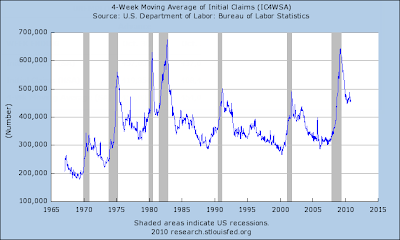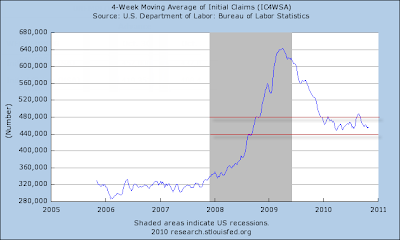Weekly Claims Show Job Stagnation for Entire Year
Courtesy of Mish
After movement in both directions over the past couple months, weekly claims are back where they have been for nearly a year, right around the 450,000 mark.
Please consider the Unemployment Weekly Claims Report for November 4, 2010.
In the week ending Oct. 30, the advance figure for seasonally adjusted initial claims was 457,000, an increase of 20,000 from the previous week’s revised figure of 437,000. The 4-week moving average was 456,000, an increase of 2,000 from the previous week’s revised average of 454,000.
The weekly claims numbers are volatile so it’s best to focus on the trend in the 4-week moving average.
4-Week Moving Average of Initial Claims
The 4-week moving average is still near the peak results of the last two recessions. It’s important to note those are raw numbers, not population adjusted. Nonetheless, the numbers do indicate broad, persistent weakness.
4-Week Moving Average of Initial Claims Since 2006
No Lasting Improvement for 12 Months
There has been no lasting improvement for nearly a year. Weekly claims have generally been in the 440,000 to 480,000 range with the 4-week moving average practically pinned to the 450,000 mark.
To be consistent with an economy adding jobs coming out of a recession, the number of claims needs to fall to the 400,000 level.
At some point employers will be as lean as they can get (and still stay in business). Yet, that does not mean businesses are about to go on a big hiring boom. Indeed, unless consumer spending picks up, they won’t.
Questions on the Weekly Claims vs. the Unemployment Rate
A question keeps popping up in emails: "How can we lose 400,000+ jobs a week and yet have the unemployment rate stay flat and the monthly jobs report show gains?"
The answer is the economy is very dynamic. People change jobs all the time. Note that from 1975 forward, the number of claims was generally above 300,000 a week, yet some months the economy added well over 250,000 jobs.
Also note that the monthly published unemployment rate is from a household survey, not a survey of payroll data from businesses. That is why the monthly "establishment survey" (a sampling of actual payroll data) is not always in alignment with changes in the unemployment rate. At economic turns the discrepancy can be wide.
Where To From Here?
Four weeks ago the weekly claims print was 475,000. That number will roll off the 4-week moving average next week. Thus any number lower than 475,000 will cause the 4-week moving average to drop.
Assuming we get a print of 450,000, next week’s 4-week moving average will decline to … drum roll please … 450,000.
As measured from weekly claims, the economy has been stagnant for a year. However, there is upward pressure on the number in light of cutbacks by state and local governments.





